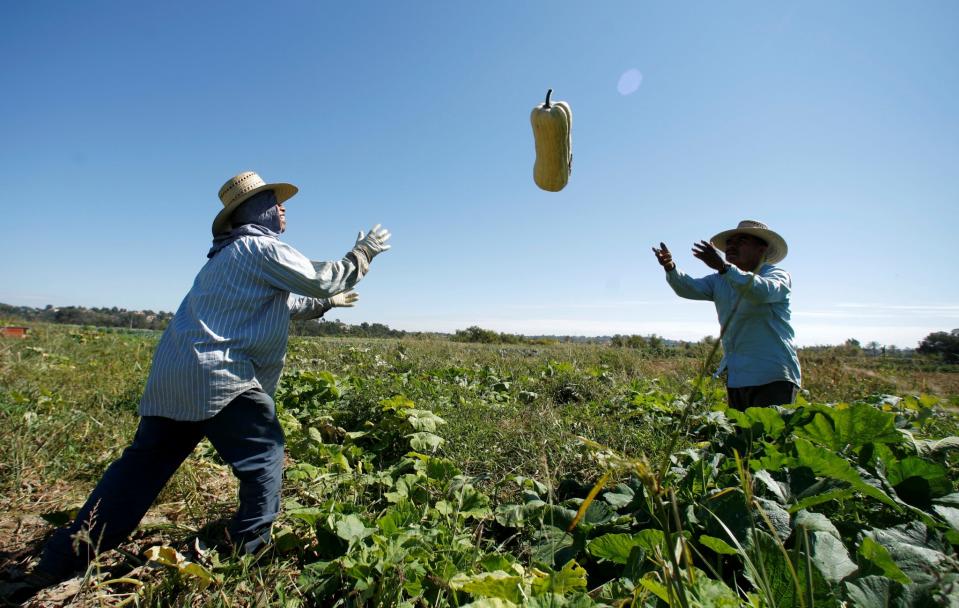Trump’s immigration cutbacks would hurt the economy
President Donald Trump has teed up another campaign promise, publicly backing a Senate bill that would cut back on immigration while admitting more high-skilled migrants and fewer low-skilled ones. This plan, however, would collide with another Trump priority: Raising economic growth beyond the lackluster 2% level of the last several years.
The Senate bill, called, in the usual clumsy fashion, the Reforming American Immigration for a Strong Economy, or RAISE, Act (get it?), would change the criteria that allow migrants legal entry to the United States. The current system relies heavily on family connections. Under the RAISE Act, priorities would be education, the ability to speak English and demonstrated accomplishments as a worker or business owner. Overall, the bill would reduce total immigration from around 1 million per year to 500,000 or so.
The idea is to draw the most talented foreigners to the United States, while restricting low-skilled immigrants who might be willing to work more cheaply than American workers, threatening those jobs. “This competitive application process will favor applicants who can speak English, financially support themselves and their families, and demonstrate skills that will contribute to our economy,” Trump said at the White House on August 2. “Reforms in the RAISE Act will give American workers a pay raise by reducing unskilled immigration.”
Limits on immigration pose risks to the economy
It’s not a fringe idea. Canada and Australia have merit-based systems similar to what the RAISE Act envisions. Some liberal groups and unions support the idea, since it might protect current American workers. But any limit on legal immigration also poses risks to the economy, because the United States actually needs more immigrant workers, not fewer, in order to grow faster and more robustly. Since Trump has vowed to produce economic growth of 3% or better during his presidency, reducing immigration would push that core campaign promise—difficult, as is—even further out of reach.
It might seem logical that stricter limits on immigration would reduce competition for jobs and leave existing workers better off. But the economy isn’t a zero-sum, fixed set of resources doled out on a per capita basis. The economy is quite dynamic (yes, even now) and when there are more people working, there are more people spending money, helping the economy grow and creating new jobs. The native-born US population is aging, which makes an infusion of immigrants necessary to fill open jobs, strengthen demand and boost growth. “More immigration is the single best way to consistently lift economic growth and standards of living,” Mark Zandi, chief economist at Moody’s Analysts, said recently at a conference live-streamed by Yahoo Finance.

In 2013, the Senate considered a bipartisan reform bill that would have allowed more legal immigrants into the United States, and permitted some migrants in the country illegally to obtain US citizenship. The bill would have increased the US population by about 10 million over 10 years, and the US labor force by 6 million, according to the Congressional Budget Office. But instead of inciting a battle for scarce jobs, the bill would have boosted GDP growth by 3.3% over a decade, and increased investment and productivity, according to the CBO. Average wages would have fallen slightly at first, then risen over the longer term. “Employment would increase as the labor force expanded,” CBO found, “because the additional population would add to demand for goods and services and, in turn, to the demand for labor.”
It’s a broadly accepted principle among economists that the economy grows as the labor force does, as long as productivity is positive and not negative. If new immigrants came to the United States and didn’t work, then immigration would be a drag on the economy. But that is not the case. The labor-force participation rate for foreign-born people 16 and over living in the United States is 65.2%, higher than the rate for native-born Americans, which is 62.3%. The unemployment rate in 2016 was 4.3% for foreign-born workers, and 5% for the native-born. So immigrants are more likely to want to work, and more likely to have a job than native-born Americans.
Immigrants also start businesses at a higher rate than native-born Americans, and not just high-flying tech companies backed by billions in venture funding. Immigrants are also more likely to run delis, nail salons, auto-repair shops and many other types of Main Street businesses. Fewer immigrants means we’ll have fewer of those, even if Trump were to succeed in luring more foreign brainiacs. Most businesses aren’t, Google, after all.
Confidential tip line: [email protected]. Encrypted communication available.
Read more:
Rick Newman is the author of four books, including Rebounders: How Winners Pivot from Setback to Success. Follow him on Twitter: @rickjnewman
